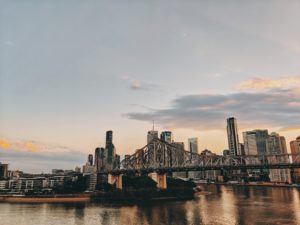Urban and environmental planner Dr Tony Matthews says there is building evidence of a mass exodus from commercial office space in the Brisbane CBD as a result of the COVID-19 pandemic and the move will have major implications for all cities in a variety of ways.
“Urban planners and designers have spent decades trying to reduce the concentration of workplaces in central business districts, with a focus on providing more workspaces in suburbs, but interventions never worked that well before 2020,” Dr Matthews said.

Dr Tony Matthews
“The opportunities for urban transformation are stronger than ever, with the loss of CBD activity giving rise to potential new populations in areas that will need careful consideration around issues of space, consumption patterns and so forth.
“The Covid-19 experience has shown us that people’s homes can work very well as their workspaces and many CBD businesses are learning this is a viable model.
“The implications on the ecosystem that has to date served the CBD model could be dramatic but will depend on two factors; the number of workers leaving the city and the population of full-time residents in the CBD.”
Recent media reports suggest companies ranging from credit unions and construction companies, accountants and gaming developers are actively looking to reduce the size of their office space tenancies by up to 50 percent.
“A CBD with a low residential population and high worker loss will suffer much more than one with a high resident population and low loss of workers,” Dr Matthews explained.
“If 10% of workers don’t come back post the pandemic, then many businesses potentially face a 10% fall in customers. Some will lose more, others less.
“Businesses will stay open or close down depending on how their profit thresholds hold up in relation to overall worker loss, but it will be different in every city and unfold differently across time.
“Something else to consider is the loss of rates collected by city authorities, to pay for certain costs in cities.
“If fewer workers are spending money in cities, businesses may close, reducing rates payments. If city authorities respond by raising rates for the remaining business, they too may close. It’s a difficult problem to balance. Many cities struggled with it after the GFC and many will again over the next few years.”

Photo by Valeriia Miller from Pexels
Dr Matthews says a lack of enthusiasm for public transport, already clearly impacted, could continue.
“A similar thing happened in some Asian cities after SARS in 2003 where public transport numbers in Beijing, for instance, never returned to pre-outbreak levels.
“Fear of exposure post-COVID and less need to travel to an office no longer located in the CBD could see a similar outcome.
“There is also emerging evidence that interest in car ownership is strongly trending up at the moment.”
Dr Matthews says parts of today’s CBD may need to be redesigned if they are no longer economically viable in their current form.
“Some retail districts might be an example of this, and some office buildings may be demolished or repurposed.
“Surrounding urban infrastructure and public space may have to change over time in response.
“There is precedent for these kinds of major urban transformations, where cities all over the world have had success in transforming old industrial spaces and waterfronts, turning them into desirable and active places with permanent residential populations.
“Attracting people back to the CBD may happen through improved urban design, rent deals, reduced business rates and so forth.
“Subsidies can be eased over time as the transformations take hold and new economies and city places start to stabilise.”
Watch this space!
